Travertine finishes
Post from EditorialsTravertine is a limestone of chemical origin with an extremely porous plot, suitable for the construction of floors and walls for interior and exterior.
Features travertine
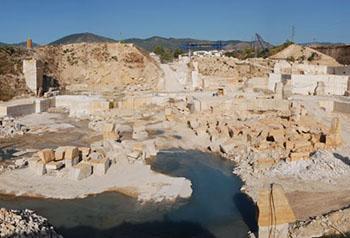 Travertine - whose name comes from Tivoli a city in the Lazio region - is a limestone that, unlike the sedimentary ones (such as limestone ammonitico) is not formed because of the accumulation and subsequent compaction of debris or living organisms, but from the precipitation of the calcium carbonate at springs (especially thermal), waterfalls or lakes, or even because of abrupt changes of temperature and pressure, or finally by the action of certain bacteria and micro-organisms that release the limestone in the form of incrustations.
Travertine - whose name comes from Tivoli a city in the Lazio region - is a limestone that, unlike the sedimentary ones (such as limestone ammonitico) is not formed because of the accumulation and subsequent compaction of debris or living organisms, but from the precipitation of the calcium carbonate at springs (especially thermal), waterfalls or lakes, or even because of abrupt changes of temperature and pressure, or finally by the action of certain bacteria and micro-organisms that release the limestone in the form of incrustations.
It look is characterized by the presence of layers more or less obvious, and a plot very porous (vaguely similar to a sponge) with small cavities, due to the original presence of leaves and organic debris now long gone. The fossils are absent, even if sometimes you notice real casts of plant matter such as leaves or twigs.
In general this is an excellent building material (used on a large scale by the ancient Romans in coatings or in the construction of entire buildings) and a good limestone; in some cases it can also be polished.
The best travertine is generally from Tivoli, but there are many quarries in Tuscany (a high quality is found also in the travertine from Siena), in Umbria and Marche: many historic buildings in Ascoli Piceno are in fact built precisely with this stone.
Types of travertine
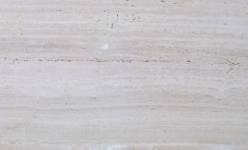 In the case of travertine, business definition coincides with the petrographic classification.
In the case of travertine, business definition coincides with the petrographic classification.
There are numerous types of travertine, which are distinguished above all for the various shades of color (arising from the various minerals - and in particular the oxides - incorporated during the process of sedimentation), the greater or lesser porosity (ie the ratio between filled and empty), and the size and orientation of the layering.
The finest travertine from an aesthetic point of view are definitely:
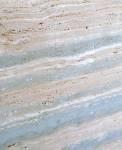 Classic travertine - Coming from the quarries of Tivoli, is very compact and relatively porous, white and pale with small uniform layers fairly straight and parallel to each other well.
Classic travertine - Coming from the quarries of Tivoli, is very compact and relatively porous, white and pale with small uniform layers fairly straight and parallel to each other well.
Travertine Silver Light - Of Italian origin, is characterized by a grain not excessive horizontal porous layers very clear and above all wonderful stripes alternating white, and blue color Havana.
Travertine New Bronze - Of an elegant light brown shade (light or dark depending on the horizontal stratification, very subtle and obvious), is an extremely pleasant appearance of travertine, polished and suitable for both indoor and outdoor use.
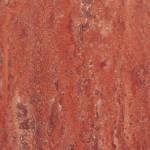 Ascoli travertine - Extract (as the name says) near Ascoli Piceno in the Marche region, it has a speckled appearance: in fact, in a beige background alternating irregular patches of white, due to the uneven distribution of the mineral pigment. The layers are not very evident, and placed randomly - that is, without a predominant direction.
Ascoli travertine - Extract (as the name says) near Ascoli Piceno in the Marche region, it has a speckled appearance: in fact, in a beige background alternating irregular patches of white, due to the uneven distribution of the mineral pigment. The layers are not very evident, and placed randomly - that is, without a predominant direction.
Ochre travertine and Red Travertine - These are two varieties (extracted from quarries located respectively in Italy and Iran) brightly colored in yellow and red because of the strong presence of compounds oxides based. The grain is fairly porous and the layers - probably due to the intense color - are not evident.
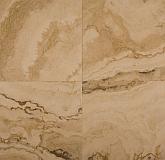 Striped travertine - It is a valuable aspect of stone, characterized by alternating wide horizontal stripes alternately light brown and dark brown. The layers are of course very obvious and tend to have a perfectly horizontal trend; the texture is rather very porous, with large cavities and real caves.
Striped travertine - It is a valuable aspect of stone, characterized by alternating wide horizontal stripes alternately light brown and dark brown. The layers are of course very obvious and tend to have a perfectly horizontal trend; the texture is rather very porous, with large cavities and real caves.
Travertine White Oniciato - Another very particular travertine, it owes its name to the jagged lines that characterize its look: the usual layers roughly horizontal veins are in fact replaced by others vaguely similar to those of onyx (hence the name) or stone paesina. The plot is rather compact and not very porous.
Design uses of travertine
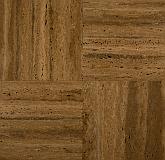 In addition to the construction of buildings, travertine is very suitable especially as ornamental material, for the execution of coatings for internal or external wall, for the realization of fireplaces and obviously stairs, thresholds, borders, jambs and moldings of various types.
In addition to the construction of buildings, travertine is very suitable especially as ornamental material, for the execution of coatings for internal or external wall, for the realization of fireplaces and obviously stairs, thresholds, borders, jambs and moldings of various types.
The companies specialized therefore offer a wide range of sheets for coatings: in addition to elements of rectangular or square shape for the flat walls, are available special pieces for coating columns, edges and stairs.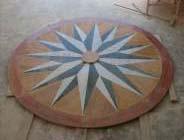 If you want special decorative effects, the sheets can be arranged by changing the orientation of horizontal layers is what provides the Company by Fratelli Pacifici, whose catalog we find a coating Travertine Striped whose veins - alternately arranged horizontally and vertically - create a pleasing checkerboard pattern.
If you want special decorative effects, the sheets can be arranged by changing the orientation of horizontal layers is what provides the Company by Fratelli Pacifici, whose catalog we find a coating Travertine Striped whose veins - alternately arranged horizontally and vertically - create a pleasing checkerboard pattern.
Alternatively, you can take advantage of the many varieties of the material for composing decorative panels (to be inserted in a wall or a floor) with the technique of opus sectile is what offers the Company Rogima Marmi, in which there is a large catalog compass also consists Ochre Travertine and Red Travertine (both also available in slabs).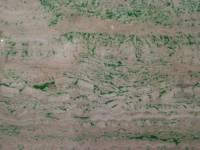 However, because of its grain very porous (which then absorbs liquids easily, staining also indelibly), this material - if not subjected to particular treatments - unfortunately does not lend itself to the creation of table tops, sinks and top of kitchens: to solve the problem, the Company Rogima Marmi offers the so-called travertine resin, that is made waterproof by impregnating it with resin.
However, because of its grain very porous (which then absorbs liquids easily, staining also indelibly), this material - if not subjected to particular treatments - unfortunately does not lend itself to the creation of table tops, sinks and top of kitchens: to solve the problem, the Company Rogima Marmi offers the so-called travertine resin, that is made waterproof by impregnating it with resin.
The treatment has also a decorative function, because using a colored resin (as seen for example in the photo on the left) you can get a nice two-tone and highlight the texture of travertine.
79163 REGISTERED USERS










